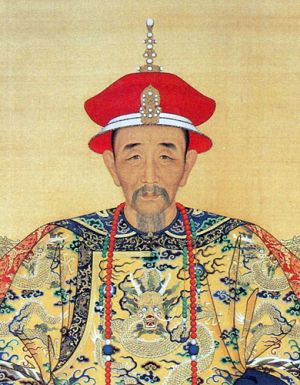Difference between revisions of "Emperor Kangxi"
imported>Ciic m (Created page with 'Acknowledged as a success among the Qing emperors, '''Emperor Kangxi''' (1654-1722) ascended the throne at age 7, and exercised full power by the age of 13. With the dual aim...') |
imported>Ciic |
||
| Line 1: | Line 1: | ||
Acknowledged as a success among the [[Qing]] emperors, '''Emperor Kangxi''' (1654-1722) ascended the throne at age 7, and exercised full power by the age of 13. With the dual aim of developing the economy and easing domestic tensions, he imposed a permanent ban on land enclosure, encouraged population growth, and ordered that taxation never be increased. In 1673, he ordered the nullification of the [[Three Feudatories]], and later crushed their rebellion. Ten years later, [[Shi Lang]] reclaimed [[Taiwan]] under Imperial Edict. After a series of battles against the Russian Empire from 1685 to 1689, Qing troops gained the advantage, and the two parties signed a peace treaty, determining the eastern border. Between 1690 and 1697, Emperor Kangxi, as commander-in-chief, launched three campaigns against the revolting Jungars, crushing the rebellions. He also sent troops to [[Tibet]] to defend the western border. Deemed as a grand phase in Chinese history, the 61-year reign of Emperor Kangxi brought remarkable advances to the empire's economy, culture and military. | Acknowledged as a success among the [[Qing]] emperors, '''Emperor Kangxi''' (1654-1722) ascended the throne at age 7, and exercised full power by the age of 13. With the dual aim of developing the economy and easing domestic tensions, he imposed a permanent ban on land enclosure, encouraged population growth, and ordered that taxation never be increased. In 1673, he ordered the nullification of the [[Three Feudatories]], and later crushed their rebellion. Ten years later, [[Shi Lang]] reclaimed [[Taiwan]] under Imperial Edict. After a series of battles against the Russian Empire from 1685 to 1689, Qing troops gained the advantage, and the two parties signed a peace treaty, determining the eastern border. Between 1690 and 1697, Emperor Kangxi, as commander-in-chief, launched three campaigns against the revolting Jungars, crushing the rebellions. He also sent troops to [[Tibet]] to defend the western border. Deemed as a grand phase in Chinese history, the 61-year reign of Emperor Kangxi brought remarkable advances to the empire's economy, culture and military. | ||
| + | |||
| + | [[File:Emperor Kangxi.jpg|thumb|Emperor Kangxi]] | ||
[[category:people]] | [[category:people]] | ||
Latest revision as of 06:22, 18 March 2010
Acknowledged as a success among the Qing emperors, Emperor Kangxi (1654-1722) ascended the throne at age 7, and exercised full power by the age of 13. With the dual aim of developing the economy and easing domestic tensions, he imposed a permanent ban on land enclosure, encouraged population growth, and ordered that taxation never be increased. In 1673, he ordered the nullification of the Three Feudatories, and later crushed their rebellion. Ten years later, Shi Lang reclaimed Taiwan under Imperial Edict. After a series of battles against the Russian Empire from 1685 to 1689, Qing troops gained the advantage, and the two parties signed a peace treaty, determining the eastern border. Between 1690 and 1697, Emperor Kangxi, as commander-in-chief, launched three campaigns against the revolting Jungars, crushing the rebellions. He also sent troops to Tibet to defend the western border. Deemed as a grand phase in Chinese history, the 61-year reign of Emperor Kangxi brought remarkable advances to the empire's economy, culture and military.
